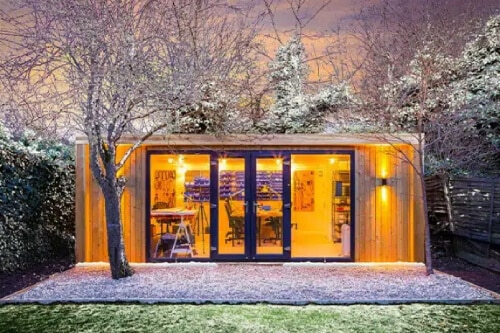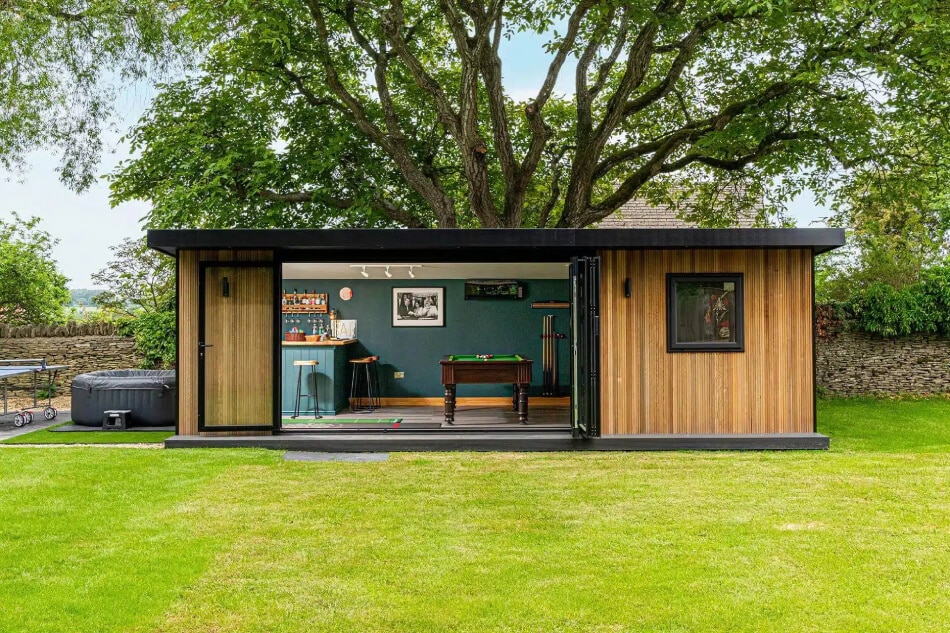Excellent News On Planning Permission On Garden Rooms
Excellent News On Planning Permission On Garden Rooms
Blog Article
In Areas Of Conservation, What Permits Do You Require For Garden Rooms And Other Structures?
There are certain restrictions that apply when constructing conservatories, garden rooms, outhouses or garden offices in conservation zones. These restrictions aim to protect the look and feel of the designated areas. Planning permits are required for conservation zones. Here are some important points to consider.
Any building or extension that falls under permitted development rights may still require planning permission in a conservation area. This includes gardens, sheds, and outbuildings.
Size and Scale
All structures of any size can require approval for planning if they are deemed to affect the character of the conservation area. The dimensions and the size of extensions or new constructions are regulated more tightly than in non-designated zones.
The location on the property
Extensions and buildings which are located on the front or sides of the property tend to require planning permission. It is also possible to get permission for buildings located behind the property, if they are visible from the public area or have an impact on the general nature of the neighborhood.
Materials and Design
Materials and design are crucial in conservation areas. It is essential that any new construction, or extension, is constructed using materials that match the historic or architectural importance of the locality. To ensure that these requirements are fulfilled, planning permission will be needed.
Demolition:
In conservation zones, it is required to obtain planning permission for the demolition of any building or part of a building, including outbuildings or wall boundaries. This is necessary in order to ensure that all changes do not alter the character of an area.
Height Restrictions
Height restrictions are stricter in conservation areas. Any structure that exceeds 2.5 meters in height (especially within 2 meters of the boundary) is likely to require planning permission.
The impact on surrounding areas
Planning permission may be required in the event that a proposed structure extension, expansion or alteration to the visual or setting of the conservation zone is likely to affect negatively the appearance of the area and its surroundings.
Building use:
A garden room, an outbuilding or studio could not require planning permission if the use is permitted.
Changes and expansions
Planning permission is typically required for extensions which exceed specified volume or size limits or alter the exterior appearance. This includes conservatories as as other major alterations.
Curtilage Structures:
In a conservation zone the structures within the boundary of a property that is listed requires approval for planning. This is for new extensions, outbuildings or changes.
The Trees are protected
In conservation areas, trees are often protected. If the proposed development will affect any trees, you may need additional permissions, including tree works consent, alongside the planning permission.
Local Authority Guideline:
Local planning authorities may establish specific guidelines for conservation zones. They may include specific guidelines regarding what is permissible and what isn't specific to the particular character of the area.
In summary, obtaining planning permission for a conservation area involves an extensive analysis of how the proposed garden room, conservatory, outhouse, garden office or extension may affect the historic and architectural character. Early discussion with the local planning authority is crucial to ensure compliance with all regulations and guidelines. Follow the recommended heating garden office for more info including garden room planning permission, garden rooms, garden rooms hertfordshire, garden outhouse, garden room planning permission, garden room conservatory, do i need planning permission for a garden room with toilet, garden out house, what size garden room without planning permission, composite garden rooms and more.
What Planning Permission Do You Need For Garden Spaces, Etc. Of Environmental Impact?
It is essential to think about the environmental impact when building garden rooms and conservatories. Be aware of these environmental issues:
Planning permission is needed when the structure is likely to have an impact on local wildlife habitats such as hedgerows, trees, or ponds. An ecological study may be needed to assess and reduce the impact on biodiversity.
Habitats and species that are protected
Permission is needed for protected species living on the property (e.g. bats, newts or other species), or if they are in protected habitats or near (e.g. Sites of Special Scientific Interest SSSI). It is important to take specific measures to protect these species.
Tree Preservation Orders
If the proposed structure involves the removal or modification of trees covered by TPOs, planning permission is necessary. The local authority will evaluate the impact and may require replacement plants or other mitigation measures.
Risks of Flood Risk and Water Management:
Planning permission is required for developments within flood-prone zones. A flood risk assessment (FRA) could be required to ensure that the building does not create more flood risk and has adequate drainage solutions.
Sustainable Construction Practices
The planning permission is required to ensure sustainable materials and construction practices. Be aware of energy efficiency as well as insulation and carbon footprint.
Drainage of Surface Water Runoff
A key consideration to consider for the environmental is how the new structure affects drainage and runoff from surface water. Planning permission will ensure that drainage systems to prevent waterlogging and flooding have been put in place.
Stability of Land and Soil:
This includes potential issues like subsidence or soil erosion especially on sloped sites. This could include problems such as a soil erosion or subsidence particularly on slopes that are steep.
Air Quality
For developments that may impact the quality of air in the local area, such as those near industrial areas or major roads Planning permission is required. It ensures air pollution levels remain within acceptable levels, and that mitigation measures are put in place.
Noise Pollution:
The permission to plan is required if you intend to use your extension to your garden or the room in a way that will create significant noise (e.g. an instrument or workshop studio). The local authority will evaluate the level of noise and potential effects on the surroundings and the neighbors.
Waste Management:
It is crucial to manage garbage properly both during and following construction. Planning permission guarantees the construction site has recycling facilities and waste disposal to minimize the environmental impact.
Energy Efficiency:
Planning permission can include conditions for energy efficiency, like the use of solar panels, high-performance glazing or other green technology. This will reduce the environmental impact of the building.
The compliance to Environmental Regulations:
Environmental regulations are at both the national and local level, including UK Environmental Protection Act. Planning permission assures that the development is in compliance with all legal and environmental standards.
Planning permission for garden office, conservatory, outhouse, or an extension, must take into consideration a number of environmental impacts. Consulting with your local planning authority early in the planning process is essential to know the specific requirements and to ensure that the development proposed is eco-friendly and in line with all relevant regulations. Take a look at the recommended what size garden room without planning permission for blog tips including garden room planning permission, small garden office, garden room vs extension, garden room or extension, what size garden room without planning permission, garden rooms near me, small garden office, gym outhouse, how to lay decking on soil, herts garden rooms and more.
In Terms Of Location Restrictions, What Kind Of Planning Permission Are You Required To Build Garden Rooms?
The area of the garden rooms or conservatories, along with outhouses, office buildings, and even garden offices can be a significant factor in determining whether permission for planning is required. Here are some key criteria for location the proximity of boundaries
If the structure is within two meters of the boundary of the property, it should not exceed a maximum height that is greater than 2.5 meters. If this height is exceeded the planning permission has to be obtained.
Front of the Property:
The permitted development right does typically not allow extensions or buildings facing forward.
Right-hand side of property:
Side extensions have to be in line with specific height and size limits and require planning permission often when they are larger than the sidewall of the home.
The back of the property
There are size and height limitations for rear extensions. If the extension exceeds permitted limits, planning approval will be needed.
Designated Zones:
In National Parks (National Parks) and Areas of Outstanding Natural Beauty(AONB) and World Heritage Sites (World Heritage Sites) more stringent control is in place. Planning permits are required for any new structure regardless of the dimensions.
List Buildings
The properties that are listed as listed have more strict regulations. Any new building or alteration will require planning consent and approval for listed buildings regardless of the location.
Green Belt Land:
Green belt land is protected by strict rules on construction to preserve open space. Permissions are usually required to construct a new structure or significant alteration.
Areas at risk of flooding
If the property is located in an area prone to flooding it is necessary to follow additional regulations to ensure that the new construction doesn't increase the risk. You might need planning permission and perhaps a flood-risk assessment.
Urban vs. Rural settings:
Urban settings typically have different regulations compared to rural ones. Rural areas may be more accommodating to the size and location of outbuildings. However, this may vary.
Highways and Public Rights of Way
If the building is located near highways, roads, or public right-of-ways, the approval of the planner may be needed to stop it from obstructing views, safety, or accessibility.
Shared Ownership and Leasehold Land
Additional permissions might be required from the managing body or freeholder for leasehold properties or part of shared-ownership schemes. The planning permission may be granted based on local laws.
In the vicinity of other structures:
If the structure being built is being constructed next to existing structures or buildings, particularly those on neighboring properties, planning permission may be required to ensure that the structure does not have a negative impact on neighboring buildings or the land.
It is recommended that you consult with your local planning authority to get specific advice tailored to your specific location and the specifics of your situation. There are different regulations depending on the local policies. In order to avoid legal issues it is crucial to follow the restrictions that apply to you. Read the top rated wooden veranda planning permission for more advice including insulated garden rooms, garden room, garden room permitted development, garden out house, how to lay decking on soil, garden rooms in St Albans, garden room planning permission, luxury outhouse, garden rooms in St Albans, how to get power to a garden room and more.